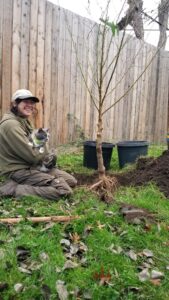Tag: planting fruit trees
Fruit tree recipients in Eugene experience almond joy, and more

NEWS FROM FRIENDS OF TREES EUGENE
FOTE’s yard tree program is growing rapidly, from 35 yard trees planted in the 2019-20 season, to 85 trees in the 2020-21 season—and fruit trees are a big part of Eugene’s yard tree program. We’ve seen a more than 100% increase in fruit trees planted this season over last—40 fruit trees this season vs just about 18 last season. And with some new outreach strategies we’re implementing to reach even more tree recipients, we expect the fruit tree popularity streak to continue.
Almond trees are the top fruit tree choice in the Eugene area (the Hall’s hardy almond tree, to be specific, which is a cross between an almond and a peach tree – !). Hall’s hardy is the only almond variety suitable for growing in the Pacific Northwest because it blooms late, resists fungal disease and self pollinates. Folks love the pretty pink flowers and that they’re fast growing—so fast, in fact that almond trees will produce almonds by the second or third season!
“I love how in just the second year my almond tree flowered profusely and grew so much; I can’t wait to try almonds this fall!”
Laurel, fruit tree recipient
We also offer apple, cherry, peach, pear, Asian pear, and plum trees, and we’re actively looking for a good local source for fig, pawpaw, and persimmon. An important feature of all fruit tree varieties offered by FOTE is that they are pest and disease resistant and don’t require spraying.
When we plant fruit trees in the Eugene area we only plant them as yard trees, and we plant as many bare root trees as possible; they are easy to plant, the roots are good, and they’re a good price for a 5-6 foot tree. We also focus on semi-dwarf varieties that max out at about 20 feet high, these are much easier for the home orchardist to care for than full sized trees (we would love to offer dwarf trees but don’t have a good source yet). Fruit tree recipients are encouraged to have a maintenance plan, because, for instance, most fruit trees need annual pruning.
Why do we expect fruit trees to increase in popularity? We think our new block-by-block outreach approach to let people know about our street and yard trees will simply just introduce fruit trees as an option many folks may not have considered.
Our block by block plan is a new approach to address equity issues within our street and yard tree program. We’re using some mapping software to prioritize neighborhoods that are more diverse, lower canopy, and lower income. Preparation Field Days involve volunteers from the relevant neighborhood association going door to door offering trees. The volunteers will be accompanied either by an FOTE staffer or someone from the City of Eugene, who will mark street tree locations and will also be available for yard tree consultations. So far when we’ve tested this method fruit trees have been very popular; they’ve been offered along with native trees and shade trees.
Would you like a fruit tree of your own? Create a free, no obligation account to get started!
Photo: Eugene Tree Team member Becca and Vera, with their Hall’s hardy almond tree, planted last November
